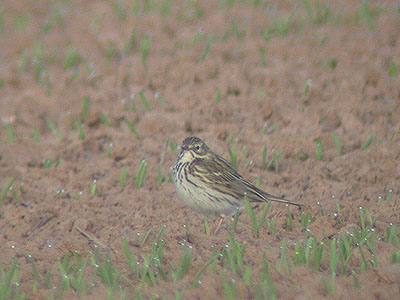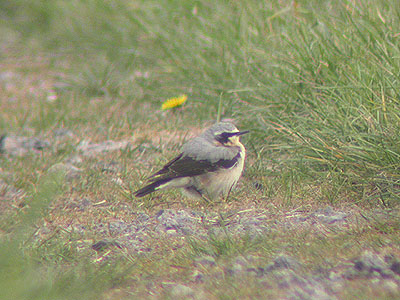

| Eakring Birds | ||
| Bird watching the Eakring and Kersall area | ||
| Many bird
watchers have a local patch. Ideally, this is close
enough to home or work to allow regular visits. How
frequently each observer visits, is completely down to
his or her decision of course. I am one of several people
within Nottinghamshire, who's bird watching activites are
entirely devoted to their local patch and rarely venture
from it. Patch watching is rewarding (the more effort,
the greater and more frequent the rewards) but at times,
it can also be frustratingly quiet and almost birdless.
One of the ways I have got over this, is to broaden my
study, to include the area's varied insect life. All bird watching sites go through so called "purple patches" - periods where an almost constant stream of rare or locally scarce species occur on an almost daily (and seemingly) impossible basis. This does seem to frequently raise a few peoples eyebrows and indeed almost visibly mystify some.This article has been written to raise awareness of just what amount of time is spent in the area, how it is worked on a daily and seasonal basis and to give an indication of just how these "purple patches" come about. Bird watchers who consistantly work any local patch, will go through these periods and a more rewarding aspect of the hobby I have yet to find. Such rewards are a return for putting in large amounts of time in the field. This is certainly the case here. Some may assume that many of the species which have occurred, really should'nt (probably because its agricultural farmland) and not a large expanse of water with amazing habitat to attract the expected. An example of this may be a species like Turnstone. |
||
| .... | ||
| The entire bird watching
conducted here, is not geared towards rarity searching.
It cannot be, because that would generally be fruitless.
Rarities do occur, but only against a back-drop of more
routine species. A minimum of a 1000 hours are put in
annually. These in turn have produced the following four,
true county rarities: Richard's Pipit, Spotted Crake,
Common Crane and Firecrest. There is often no typical or standard daily routine here. Much of the day's bird watching being planned the night before by watching the weather forecast, looking for the correct or certain conditions and then judging the most likely routine for the next day. Previous experience in the field certainly helps in the decision making, where years of learning what could turn up, where and in what conditions, frequently pays dividends when such species are looked for. Much also depends upon time of year. During the peak migration months, much of the work is based doing visible migration watches from Red Hill. This particularly applies to Autumn, more than Spring. |
 |
|
| .... | ||
| Spring Visible migration in Spring is generally very quiet from mid-April onwards and concentration is then geared towards monitoring the overnight arrival of warblers and checking open fields for Wheatears. Prior to this, from early March, visible migration watches take up a great deal of time to monitor species like Meadow Pipit and Linnet. Peak dates for many passerines are usually quite predictable, but do rely on the right weather. This is also a good time for migrant raptors, so a good vantage point is essential. If conditions are right for terns and waders, then activity is centred around Eakring Flash for much of the time, but the whole area is covered almost daily. As a general rule, if it rains from the last week of April until mid-May, then Eakring Flash recieves most daily coverage in order to add typically brief waders to the annual year list. Keeping such a list acts as an incentive, encouraging more hours in the field in order to help beat previous totals. By mid-May, much of Spring migration is over and the area becomes much quieter. May can be a dull month, with long periods of little or nothing, but late warblers continue to arrive and these continue to be recorded and territories mapped. Summer The generally quieter Summer months are spent monitoring the area's breeding birds and listening for Quail. Three years out of five having produced calling birds now, including an unprecidented influx into the area during 2001. These "quieter" months can often produce some unexpected records, but the last week of June, sees the start of return passage by a number of waders, Sand Martins and a few early warblers. As July progresses, the pace of Autumn migration begins to quicken and visits become longer and more frequent and the first visible migration watches start. Autumn Visible migration watches reach a peak during September and October (often continuing well into November) Counting passerines in this way, will often also produce raptor records. Keeping an "eye on the sky" has resulted in almost annual records of species like Osprey, Marsh Harrier, Red Kite and Honey Buzzard here. Autumn is prime-time birdwatching. Its far more productive than Spring can ever be, counts of regular migrants are vastly higher than during the early part of the year and there is also far more variety. Late September onwards can be so busy, with flock after flock of birds passing through needing to be identified, sorted and then counted. Things can get hectic on good days, but the whole experience is phenominally exciting. Watching for coastal migrant arrivals will (in most instances) reap rewards within a few days, usually with species like Redstart and Whinchat. These are the kind of birds I personally aim for. During the early part of the Autumn, many hours are spent systematically working the favoured haunts of chats and warblers, by working certain hedgerows and within Eakring village itself. Time allocated to visible migration watching is less. Sometimes it can take well over an hour to work a particular stretch of hedge or a site like Penny Pasture Common. |
||
| .... | ||
 |
First stop-off point from
mid-September is Red Hill, to assess the general
"feel" of the morning. If birds are noted
passing through almost instantly, then much of the
morning/day can be spent there, checking other sites in
the area when lulls in movements occur or cease. The whole aspect of visible migration watching has accounted for some of the area's best records, such as the Richard's Pipit in 1998 and two Woodlark in 2001. Both would have been missed had it not been obvious that a wide variety of species were on the move on those days, allowing coverage to be increased. Its also worth noting that certain species frequently associate with others and being aware of this helps in their discovery. Its basically all about the amount of coverage that can be devoted to any given area. The more is put in, the more is taken out. The rewards are there at any site, if one is prepared to work at it continuously. |
|
| .... | ||
| Winter After the excitement of October/November's migrant thrush arrivals, migration peaks and the area becomes quiet again and more hours have to be put in to obtain any rewards. Cold weather movements are rare in these days of warmer Winters and snow even more so. Unless such weather does materialise, most of the birdwatching is undertaken from several roadside viewpoints or at Eakring Flash. Weekly checks are made for species like Jack Snipe and Woodcock at traditional locations. |
||